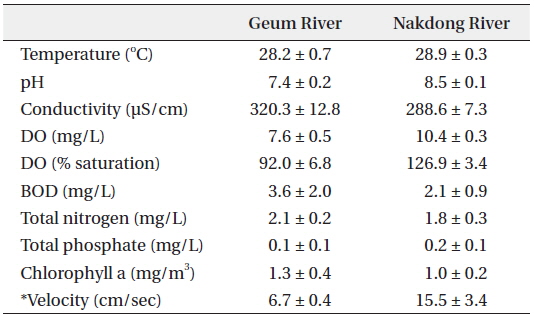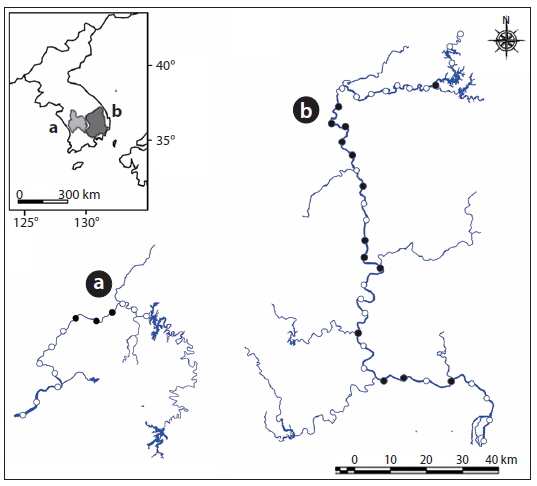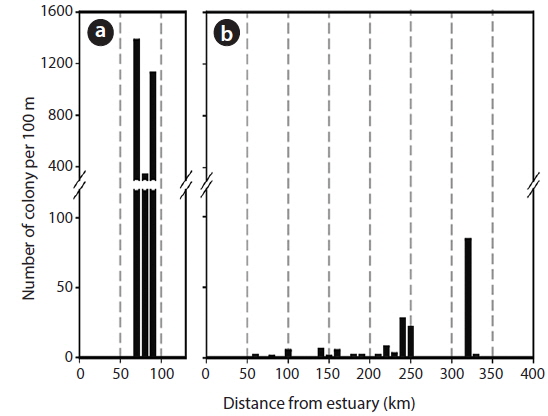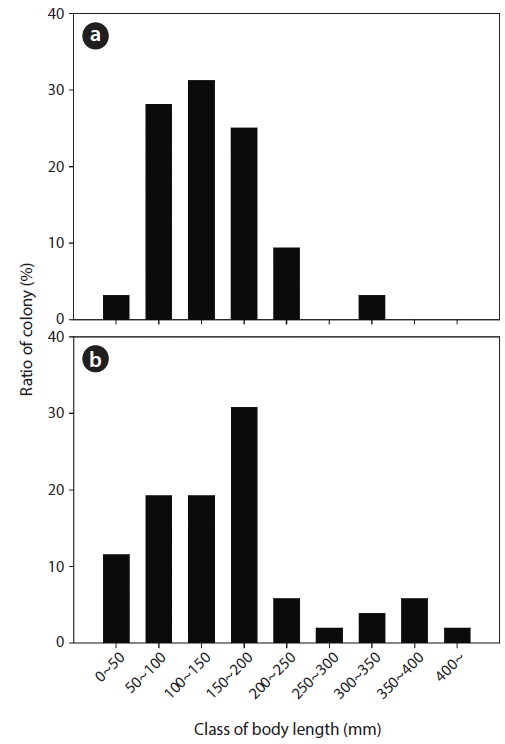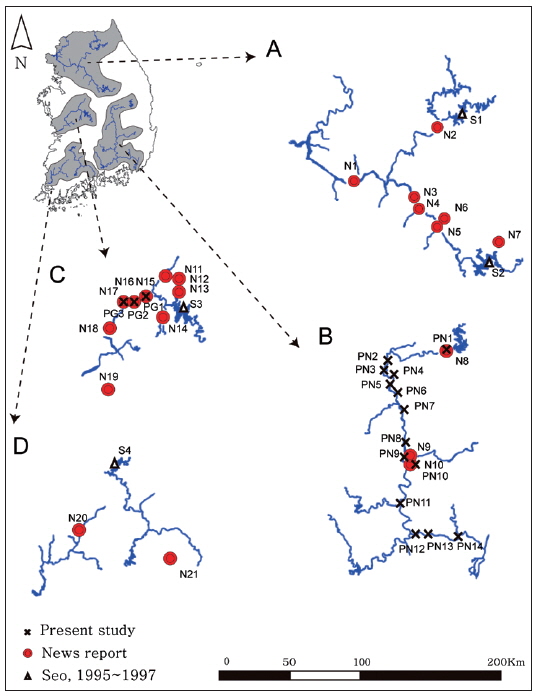Bryozoans are common animals that attach to submerged surfaces in freshwater, and they are found throughout the world. Pectinatella magnifica, one of the largest freshwater bryozoans, is a native of the area east of the Mississippi River from Ontario to Florida in USA (Wood 2001). In past decades, it has expanded throughout Northern America. Pectinatella magnifica has not only invaded Western North America region but also Europe and East Asia including Japan and South Korea (Wood 2001). According to the literature, there are 94 freshwater species (Massard and Geimer 2008) with 11 freshwater bryozoan species including P. magnifica being reported in South Korea (Seo 1998).
Scientific studies of P. magnifica have mainly been conducted in North America since the early 20th century (Davenport 1900, Wilcox 1906, Brooks 1929). Studies outside North America on P. magnifica began in the 1970’s following the invasion of Japan (Mawatari 1973, Oda 1974). In the early 2000’s, European countries started distributional studies of this species (Massard and Geimer 2002, Balounová et al. 2011, Šetlíková et al. 2013). According to Oda (1974), this species also spreads by zoochory (dispersal of statoblasts on feathers of birds). Dispersal by aquatic animals and transportation by fish (fingerling) in aquaculture is also probable in South Korea (Seo 1998).
Using presence and absence information in lakes, most of the distributional studies have shown distribution patterns of this invasion species (Massard and Geimer 2002, Balounová et al. 2011, 2013). Quantitative information about colony size and biomass distribution has been rarely conducted (Joo et al. 1992, Šetlíková et al. 2013). In summer 2014, large colony developments were observed in four large rivers in South Korea. In this study, therefore, we conducted a survey of P. magnifica to determine the distribution pattern and the quantitative information about colony size and length between two different large rivers in South Korea.
Distribution of P. magnifica was investigated on main channels of two different large rivers in South Korea (Fig. 1). One of large rivers was Nakdong River laid on southeastern part of South Korea. Another is Geum River laid on west part of South Korea. The main channels were totally modified due to the four Large River Projects (4LRP) which implements large weirs along the main channels of 4 large rivers for flood control and water supplementation (Normile 2010). Specifically, eight large weirs (50% of all weirs) constructed along the main channel of the Nakdong River (300 km of total 514 km). The depth of the river changed from 1-2 m to 6-7 m while the channel width changed from 240-300 m to 350-530 m. Three large weirs were built in the Geum River main channel and this river suffered similar physical changes like the Nakdong River.
We conducted a distributional survey of P. magnifica from July 12 to July 25, 2014. The study site interval was 10 km along the main channel of the Nakdong River (n = 38; 380 km; “n” represent the number of sites hereafter) and Geum River (n = 12; 120 km) from the estuarine barrage to upper reaches of the main channel. We counted colony numbers of P. magnifica at randomly chosen locations (about 100 m) along the riparian zone at each sampling point (10 km intervals). Body length (mm) and weight (g) of P. magnifica were also measured. Additionally, water temperature, pH, conductivity, dissolved oxygen, and water velocity were measured. A DO meter (YSI Model 58; Fisher Scientific, Hampton, NH, USA) was used to measure water temperature and dissolved oxygen, while conductivity and pH were measured using a conductivity meter (Model 152; Fisher Scientific) and pH meter (Orion Model 250A; Cole- Parmer, Vernon Hills, IL, USA), respectively. Water velocity was measured using velocity instrument (Model 3631; Yokogawa, Tokyo, Japan) along the riparian zone. Other factors (e.g., biological oxygen demand, total nitrogen, total phosphate, and chlorophyll a) were obtained from K-water website (K-water 2014). The precipitation data were obtained from eight meteorological stations of the Korean Meteorological Administration (KMA) from March 1 to July 31, 2010 to 2014 (5 years), located in basin of the Geum River (Cheongju, Daejeon, Buyeo, and Gunsan) and Nakdong River (Taebaek, Andong, Yeongju, and Waegwan). To determine if any distribution pattern existed in the literature, we searched distribution region of P. magnifica using literature, seminar reports and, media reports.
Basic water quality showed difference between each sampling point in the two river ecosystems (Table 1 and Appendices 1 and 2). pH in Nakdong River (8.5 ± 0.1: mean ± standard deviation) was higher than that in the Geum River (7.4 ± 0.2). Comparatively, dissolved oxygen (mg/L, % saturation) in the Nakdong River (10.4 ± 0.1 mg/L, 126.9 ± 3.4%) was also higher than in the Geum River (7.6 ± 0.5 mg/L, 92.0 ± 6.8%). Biological oxygen demand (mg/L) in the Geum River (3.6 ± 2.0) was higher than in Nakdong River (2.1 ± 0.9). However, conductivity in the Geum River (320.3 ± 12.8 μS/cm) was higher than in the Nakdong River (288.6 ± 7.3). Nutrient such as nitrogen, phosphate, and chlorophyll a were similar in the two river ecosystem. Alternatively, water velocity in the Nakdong River (15.5 ± 3.4 s/cm) was 2.5 fold higher than that in the Geum River (6.7 ± 0.4 s/cm). Rainfall lead to increase of water velocity and decrease residence time in the river ecosystem (Jeong et al. 2007). Rainfall from March to July in 2014 was very low compared to previous years (2010−2013) in the Geum River (mean of rainfall in 2010 to 2013, 744 ± 138 mm; rainfall in 2014, 468 mm (62% of total rainfall) and Nakdong River (mean: 609 ± 117 mm; rainfall in 2014, 350 mm (51%)). Therefore, the massive development of P. magnifica possibly may be the result of very low rainfall and the interaction with other environmental variables.
The distribution pattern of P. magnifica is shown in Fig. 1. The present rate of P. magnifica in the Nakdong and Geum Rivers was 32.6% and 25%, respectively. Looking at a comparison of P. magnifica colony numbers, colony number in the Geum River (9.49 ± 3.14 colony/m, n = 3) was more than 94 fold higher than in the Nakdong River (0.11 ± 0.05 colony/m, n = 16; Fig. 2). We observed higher value of water velocity at sampling point with presence of P. magnifica (on average, 17.4 cm/s) than that at point with absence of P. magnifica (8.3 cm/s). The total length distribution of P. magnifica had a truncated bell shape at each river: mean lengths were 14.0 ± 1.2 for Geum River (n = 32), 16.8 ± 1.4 for Nakdong River (n = 52). The body length of P. magnifica colonies in Nakdong River and Geum River ranged from 50 to 200 mm and 100 to 250 mm, respectively (Fig. 3). In the Geum River, P. magnifica colonies were abundant between 100 to 150 mm, while in the Nakdong River, colonies between 150 and 200 mm were most abundant.
According to Seo (1998), P. magnifica was observed mainly in lentic freshwater ecosystems such as lake and reservoirs in South Korea. However, in our review of P. magnifica distribution in South Korea, this species can be found in both lentic and in lotic ecosystems (Fig. 4). There are possibilities for diffusion due to several reasons (e.g., water flow, migratory birds, fish, fish farm, and boat); however, P. magnifica statoblasts are mainly thought to be dispersed by hydrochloric transport along the river on flow and between water reservoirs by water birds (Balounová et al. 2013). This indicates that the spread of P. magnifica is not a local characteristic but has occurred nation-wide simultaneously. Therefore, we could assume anthropogenic factors such as weir or dam construction (i.e., 4LRP) that might provide ideal habitat and contribute to the massive development of this invasive species.
In conclusion, our results provided a quantitative comparison of P. magnifica distribution between the Geum River and Nakdong River. We could also detect differences in distribution patterns, colony numbers, and total length distribution and the relationship between total length and weight of P. magnifica between the two different large rivers. These findings could provide basic information about the distribution pattern of P. magnifica in a new invasion area. At present, it is not clear why the massive development of P. magnifica has been observed in the middle reaches of Geum River and upper reaches of Nakdong River. The aforementioned studies of P. magnifica were limited to its distribution and basic ecology. We, therefore, need to determine food-web structure and interaction with other aquatic organisms using advanced technical tools like stable isotope analysis and molecular approaches in further studies. Detailed hydrological evaluation of the river section where colony development was exceptionally high is also needed for a better understanding of P. magnifica colony development.




